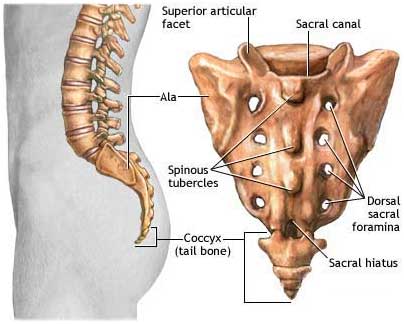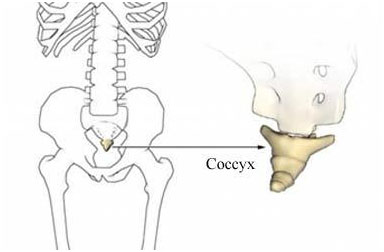
Coccydynia

Coccydynia is a medical term meaning pain in the coccyx or tailbone area, usually brought on by sitting too abruptly. Coccydynia is also known as coccygodynia, coccygeal pain, coccyx pain, or coccalgia
Orientations of the coccyx -
There are four different orientations for the coccyx
1. Type I the coccyx is curved anteriorly with its apex facing downward and caudally.
2. Type II this forward curvature is more dramatic and the apex extends forward.
3. Type III is where the coccyx angles forward sharply.
4. Type IV is characterized by the coccyx being subluxated at the sacrococcygeal joint.

Angle of Incidence -
Sagittal coccygeal movement is measured using the angle of incidence or the angle at which the coccyx strikes the seat when an individual sits down.
1. A smaller angle indicates the coccyx being more parallel to the seat, resulting in flexion (or “normal” movement) of the coccyx.
2. A larger angle indicates the coccyx being more perpendicular to the seat, causing posterior subluxation (or “backward” movement) of the coccyx.
Cause -
1. Sudden impact due to fall
2. Childbirth pressure in women
3. Excessive sitting or sitting improperly
4. Repetitive trauma of the surrounding ligaments and muscles, resulting in inflammation of tissues and pain
5. Fractured coccyx
6. Bicycling
7. Tumor in the vicinity of the coccyx (sacrococcygeal teratoma)
8. Falling
9. Horseback riding
10. Even sitting on hard surfaces for a long period of time
11. Obese
12. Bike riding
13. Canoeing.
14. Long car or Airplane rides
15. Degenerative joint changes
Diagnose -
1. X-rays
2. MRI
Clinical Features -
1. Pain t worsens with constipation and may be relieved with bowel movement.
2. Sexual intercourse can aggravate symptoms.
3. Menstruation uncomfortable
Treatment -
1. Local nerve block injection at the ganglion can give relief of coccydynia when performed under fluoroscopic guidance.
2. Hockey pants
3. Stool softeners and increased fiber in the diet may help.
4. A cushion with a cutout at the back under the coccyx is recommended. Sit on a doughnut-shaped pillow or wedge (U-shape or V-shaped) cushion
5. Water intake is recommended.
Physiotherapy Treatment -
1. Manipulation
2. Stretches & Strengthening Exercises-
• The adductor magnus is involved in the kneeling groin stretch, and when it is tight it can contribute to tailbone pain, so stretching can help prevent tailbone pain.
• Other stretches like piriformis stretch, levater ani stretch , and hands to feet stretch, can relieve stress off the muscles around the coccyx. These release tension built up around the muscles in the coccyx.
3. Applying ice or a cold pack to the area several times a day
4. Pelvic floor relaxation techniques, such as breathing deeply and completely relaxing the pelvic floor
5. Myofascial release techniques
6. Modalities for pain relief. E.g.-U.S, S.W.D, IFT
7. Massaging the muscles attached to the tailbone might help reduce pain.

